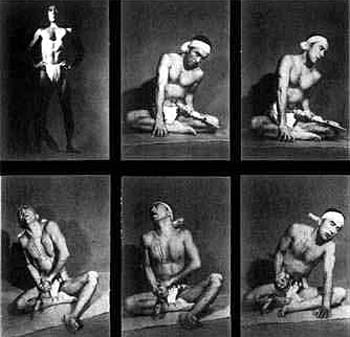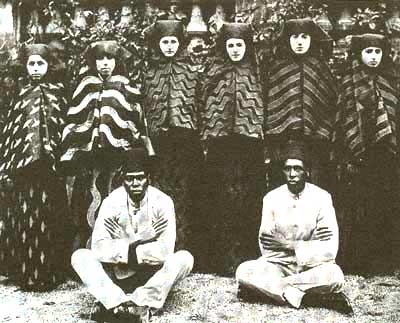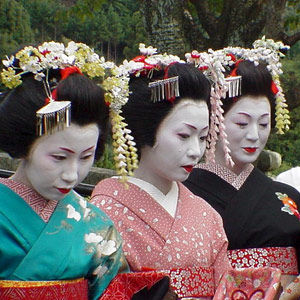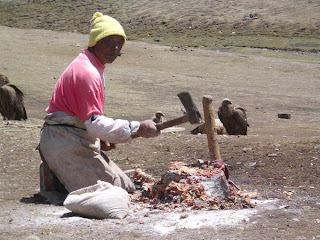Binding of the foot usually starts from a child aged between 4-7 years. The poor are usually too late to start binding the feet because they need the help of their daughters in the care of the rice fields and plantations.
Foot binding began during the late Tang Dynasty (618-907) and began menybar in group classes up until the Song dynasty (960-1297), pd Ming Dynasty (1368-1644) and Qing dynasty (1644-1911), cultural foot binding was widespread in China until the majority eventually banned in the Revolution of Sun Yat Sen in 1911.
Foot binding is done by way of legs wrapped tightly using a cloth sepnjng ten feet by two inches wide, folded four toes to the bottom of the foot and pull your toes medekati heel. This makes mnjdi shorter legs.
Leggings increasingly diketatkan from day to day and feet forced to wear shoes that are getting smaller. Feet should be washed and cut his nails because otherwise it would make the nails of the feet at the foot of which was tied into the piercing and cause infection. If the bandage is too tight it can arise book "in the legs should be cut with a knife.
Then the feet should also be massaged and compressed cold and heat to slightly reduce the pain. Binding of the foot makes the blood cycle is not smooth so it can make a rotten meat legs and feet may ooze pus. The smaller the feet of a girl the more beautiful it is seen. Long legs of a girl is only about 10-15 cm only.
2.Self mummification
 Sokushinbutsu is a Buddhist monk or priest who is accused of causing death by making them into mummies. This practice is reported to occur almost exclusively in northern Japan around Yamagata Prefecture. There are between 16 to 24 mummies have been found.
Sokushinbutsu is a Buddhist monk or priest who is accused of causing death by making them into mummies. This practice is reported to occur almost exclusively in northern Japan around Yamagata Prefecture. There are between 16 to 24 mummies have been found.Three years the priests only to eat a special diet consisting of nuts and seeds, they then just eating the bark and roots within three years and began drinking tea made from the sap of poison the Urushi tree, normally used to lacquer bowls.
It causes vomiting and rapid loss of body fluids, and most importantly, turn off the body which can cause damage to the body that can cause death.
Finally, in mummifying monk would lock himself in the grave stone that size is hardly bigger than his body, in which he will not move from his position. Liaison to the outside world is the air tube. Every day he reminds that people outside that he was still alive.
3.eunuchs
 Eunuchs also called the eunuch, a man who had lost their fertility due to his genitals had been removed intentionally or due to causes lain.Catatan-the earliest record of castration on purpose to produce eunuchs are from the Sumerian city of Lagash in the 21st century BC .
Eunuchs also called the eunuch, a man who had lost their fertility due to his genitals had been removed intentionally or due to causes lain.Catatan-the earliest record of castration on purpose to produce eunuchs are from the Sumerian city of Lagash in the 21st century BC .The first eunuch mentioned in the Assyrian Empire (ca. 850 to 622 BC). They usually appear at the palace of the Achaemenid emperors of Persia or the pharaoh of Egypt (up Lagid dynasty known as Ptolemy, which ended with Cleopatra).At the end of the Ming Dynasty there are 70,000 people in the Imperial palace eunuchs.
Such positions are so valuable, some eunuchs managed to get a power so great that it exceeds the power of the prime minister, so that self-castration should be banned. The number of eunuchs into the Imperial Palace officials eventually declined to 470 people in 1912, when they are no longer employed.
Eunuchs be given positions of civil servants are so high on the grounds that because they can not have children, they will not be tempted to seize power and start a dynasty. At the same time, a similar system also exists in Vietnam.
4.sati
The tradition of sati is seen as a better alternative when a wife widowed by their husbands, than they have experienced torture of brothers-in-law, who would blame women for causing dead husband.
Sati became a tradition does not only apply to the wife, but also for saving wife, brother-in-law and even mothers, to sacrifice himself diapi burning bodies of men who have sati mereka.pelaku heralded as a hero, in accordance with the teachings of Hindu
5.dueling
 Dueling tradition practiced in the 15-20 century Western society, which is a duel between two people, matched with the weapons of death, in accordance with rules explicitly or implicitly agreed upon, as a symbol of honor, usually accompanied by a trusted representative.
Dueling tradition practiced in the 15-20 century Western society, which is a duel between two people, matched with the weapons of death, in accordance with rules explicitly or implicitly agreed upon, as a symbol of honor, usually accompanied by a trusted representative.Dueling usually occurs because one party wants (the challenger) because they have committed an insult to her honor. The purpose of dueling is none other than for sheer satisfaction, to restore their honor status was willing to risk nyawa.dueling can usually be done with a sword or a gun
6.seppuku
 Called Harakiri Seppuku, One tradition that became the pride of Japanese society, which is derived from the nutrient, which means the stomach and that means cutting kiru. Harakiri is also known as seppuku.
Called Harakiri Seppuku, One tradition that became the pride of Japanese society, which is derived from the nutrient, which means the stomach and that means cutting kiru. Harakiri is also known as seppuku.Harakiri habits was conducted by soldiers from among the samurai class as proof of loyalty. Suicide of the Samurai was very painful, because the actors have to wait for death from loss of blood after a tear and took out his bowels.
There is a special ritual to be performed by the Samurai if you want to commit harakiri. He must shower, use a white robe, and eat favorite foods. Perpetrator suicide accompanied by a servant (kaishakunin), which he chose himself.
Kaishakunin is tasked to open her robe and fetched a knife to be used. If the perpetrators of suicide screaming or crying in pain when he cut and pulled out his bowels, it is considered very shameful for a Samurai. Therefore Kaishaku duty to reduce pain, hasten death by beheading the offender
7.Human sacrifice
These offerings vary, beberpa such as the Mayans and Aztecs that they are notorious for offering ceremony, while others have appeared as a primitive practice.
Sacrifice was killed in a different way, there was a burned, beheaded, or buried alive. can be either small children or virgins.
8.Concubinage
 a group of concubines was standing behind their patron (usually eunuchs).
a group of concubines was standing behind their patron (usually eunuchs).9.geisha
 Geisha originated from the word "gei" meaning art or performances in Japanese and "Sha" means people, so Geisha (person of the arts) is a traditional artist entertainer in Japan.
Geisha originated from the word "gei" meaning art or performances in Japanese and "Sha" means people, so Geisha (person of the arts) is a traditional artist entertainer in Japan.In Kyoto itself, the word "Geiko" is used to illustrate the artists like that. The presence of geisha in 18th and 19th centuries are common and up to now they too are still there even though their numbers are dwindling sdh. Geisha are traditionally trained since their childhood.
Geisha houses often bought young girls from poor families and take responsibility for raising and training them.
10.tibetan sky burial
 Tibet is a region in Central Asia and penara original petempatan for Tibetan people. Average with a height of 4.900 meters (16.000 feet), Tibet is the highest shoreline in Earth and often hold a "tube of the World."
Tibet is a region in Central Asia and penara original petempatan for Tibetan people. Average with a height of 4.900 meters (16.000 feet), Tibet is the highest shoreline in Earth and often hold a "tube of the World."BGI Tibetans, who are Buddhists, the land mreka residence situated on a hill where no soft ground. Almost all of them filled with stones or salji / water batu.Oleh kerana graveyard soil caused no geographic circumstances, they gave the corpse to be eaten by birds.
Besides, that way the spirit of the dead is believed to be eternal in the mountains with respect to birds.
source: http://all-mistery.blogspot.com/2010/07/10-tradisi-paling-mengerikan-di-dunia.html




0 comments:
Post a Comment